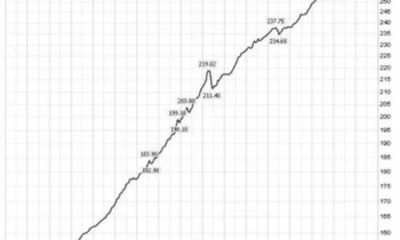Economics
The tightening interest rate cycle is now biting
With the exception of the Reserve Bank of New Zealand, which commenced its monetary policy tightening cycle in October 2021, well ahead of their English-speaking…


With the exception of the Reserve Bank of New Zealand, which commenced its monetary policy tightening cycle in October 2021, well ahead of their English-speaking counterparts – the other major English-speaking Central Banks have tried to play “catch-up football” in recent months to counter the multi-decade growth in inflationary expectations.
Since June 2022, the U.S. Federal Reserve have tightened twice by 0.75 per cent in July and September, respectively, to over 3.0 per cent. The Bank of England increased twice by 0.5 per cent in August and September to 2.25 per cent – but their economy is, on a relative basis, under enormous pressure from the brutal increase in energy prices. The Bank of Canada tightened by 1.0 per cent in July and 0.75 per cent in September to 3.25 per cent. And the slow coach of the class, the Reserve Bank of Australia, increased four times, by 0.5 per cent in each of July, August and September, and by 0.25 per cent in October, to 2.60 per cent.
The average increase in official cash rates amongst the five English-speaking economies sampled below since June is 1.50 per cent.
Changes to official cash rates (%)
|
New Zealand Date |
% |
USA
Date |
% |
UK
Date |
% |
Canada
Date |
% |
Australia
Date |
% |
|
2021 |
|
|
|
|
|
|
|
|
|
|
6/10 |
0.50 |
|
|
|
|
|
|
|
|
|
24/10 |
0.75 |
|
|
16/12 |
0.25 |
|
|
|
|
|
2022 |
|
|
|
|
|
|
|
|
|
|
23/2 |
1.00 |
17/3 |
0.25 |
3/2 |
0.50 |
26/1 |
0.25 |
6/4 |
0.35 |
|
13/4 |
1.50 |
5/5 |
0.75 |
17/3 |
0.75 |
2/3 |
0.50 |
8/6 |
0.85 |
|
25/5 |
2.00 |
15/6 |
1.50 |
5/5 |
1.00 |
13/4 |
1.00 |
5/7 |
1.35 |
|
13/7 |
2.50 |
27/7 |
2.25 |
16/6 |
1.25 |
1/6 |
1.50 |
2/8 |
1.85 |
|
17/8 |
3.00 |
21/9 |
3.00 |
4/8 |
1.75 |
14/7 |
2.50 |
6/9 |
2.35 |
|
|
|
|
|
22/9 |
2.25 |
8/9 |
3.25 |
4/10 |
2.60 |
|
Increase since June ‘22 |
+1.00 |
|
+1.50 |
|
+1.25 |
|
+1.75 |
|
+1.75 |
On Monday night the U.S. Institute for Supply Management’s measure for new orders in September declined by more than 4 points to 47.1, the lowest level since the early months of the COVID-19 pandemic and an indication that demand is softening. Companies are adjusting to potential future lower demand.
The combination of large consumer indebtedness, declining residential prices admittedly from eye-watering levels, and the large jump in cost of living via energy and fuel costs is seeing the tightening interest rate cycle starting to bite across the major English-speaking economies.
Logically, the Central Banks should exhibit greater restraint in their tightening process over the foreseeable future.

Argentina Is One of the Most Regulated Countries in the World
In the coming days and weeks, we can expect further, far‐reaching reform proposals that will go through the Argentine congress.
Crypto, Crude, & Crap Stocks Rally As Yield Curve Steepens, Rate-Cut Hopes Soar
Crypto, Crude, & Crap Stocks Rally As Yield Curve Steepens, Rate-Cut Hopes Soar
A weird week of macro data – strong jobless claims but…
Fed Pivot: A Blend of Confidence and Folly
Fed Pivot: Charting a New Course in Economic Strategy Dec 22, 2023 Introduction In the dynamic world of economics, the Federal Reserve, the central bank…



















